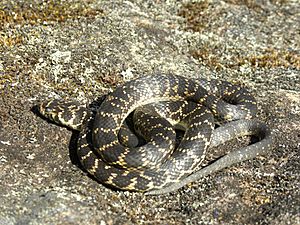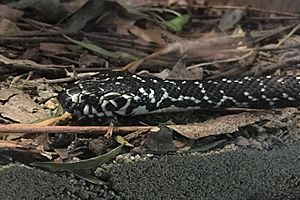Broad-headed snake facts for kids
Quick facts for kids Broad-headed snake |
|
|---|---|
 |
|
| Conservation status | |
| Scientific classification | |
| Genus: |
Hoplocephalus
|
| Species: |
bungaroides
|
The broad-headed snake (Hoplocephalus bungaroides) is a venomous snake found only in the Sydney area of New South Wales, Australia. It is one of three snakes in its group, Hoplocephalus, all of which live in eastern Australia. This snake is currently in danger of disappearing. It is listed as an endangered species in New South Wales and vulnerable across Australia.
Contents
What Does the Broad-Headed Snake Look Like?
The broad-headed snake is a small to medium-sized snake. It is also a venomous snake. Most adult snakes grow to about 60 cm long. Some have even been recorded at 90 cm.
These snakes are black with many yellow markings. These markings form narrow bands across their body. Because of their looks, people sometimes confuse them with young Diamond Pythons. Both snakes live in the same areas.
Where Do Broad-Headed Snakes Live?
Broad-headed snakes live in the Sydney Basin in New South Wales, Australia. The places they choose to live depend on many things. These include the temperature, their age, and if they are ready to have babies.
During colder months, adult and young snakes hide in cracks in sandstone rocks. They like sunny cliff edges to stay warm. When spring arrives and it gets warmer, adult males and females that are not having babies move. They go into nearby forests and woodlands. They live in hollow trees during the summer. Young snakes and females that are pregnant stay in the rocks. They move to cooler, shady spots.
Sadly, the places where these snakes live are being harmed. This is due to cities growing, rocks being illegally removed, and people collecting reptiles. The sandstone rocks are often taken for gardens. This means the snakes lose their homes and places to find food.
How Do Broad-Headed Snakes Behave?
What Do Broad-Headed Snakes Eat?
Broad-headed snakes do not eat very often. They mostly eat small reptiles and mammals. Snakes kept in zoos can stay healthy by eating one or two small rats each month. One snake was even known to go without food for a whole year!
Young snakes mostly eat Lesueur's velvet geckos (Amalosia lesueurii). They also sometimes eat small skinks. Adult snakes eat these geckos too. But they also hunt other lizards, small-eyed snakes, and mice.
How Do Broad-Headed Snakes Have Babies?
Male broad-headed snakes are ready to have babies when they are about five years old. Females need to be about six years old. Mating happens from autumn to spring. Adult females have babies every two years.
Unlike many other venomous snakes, the broad-headed snake gives birth to live young. Babies are born between January and April. Each mother usually has 4 to 12 babies. The babies are born inside a clear sack. Sometimes, some eggs do not get fertilized, or some babies are born not alive.
Why Are Broad-Headed Snakes in Danger?
The broad-headed snake used to be common in parts of Sydney. This included areas around Sydney Harbour. But now, it is an endangered species in New South Wales. It is also listed as vulnerable across Australia.
Their numbers are going down for several reasons. These include losing their homes as cities grow. Also, people illegally remove the bush rocks they live under. And some people collect these snakes without permission.



